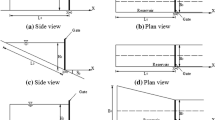Abstract
Although dike-break and dam-break processes have similar unsteady and discontinuous hydrodynamic characteristics, there are significant differences. In general, dam-break simulations focus on the flood discharge, whereas dike-break simulations are required to provide detailed information on the hydraulic and breach evolution processes, such as pit-scour and breach-expansion. In order to overcome the difficulties inherent in applying existing dam-break models to dike-breaks, this paper presents an integrated model that combines the shallow water, sediment transport, riverbed deformation and breach-expansion equations. A Godunov-type finite volume method is used for the flow simulation, based on a fixed quadtree grid system. The hydrodynamic aspects of the model are validated for an idealized rectangular dam break. A representative reach in the Yellow River is selected at a location where there is a significant risk of a dike-break, and full-scale topographic and hydrologic data are available. Typical dike-break processes are successfully simulated, with predicted hydraulic characteristics and terrain changes qualitatively in agreement with laboratory data. The modeling study is of practical importance for implementation of engineering countermeasures in the Yellow River, such as breach blocking and head wrapping.
Similar content being viewed by others
References
Hu Yisan, Flood-control system on the downstream of the Yellow River, Yellow River (in Chinese), 1996, 8: 1–6.
Huang Shuge, Some suggestions of experts to breach-blocking on the Yellow River, Yellow River (in Chinese), 1999, 21(6): 10.
Wurbs, R. A., Dam-breach flood wave models, Journal of Hydraulic Engineering, ASCE, 1987, 113(1): 29–46.
Tan Weiyan, Hu Siyi, A new direction and developments in computational shallow water hydrodynamics, Advances in Water Science (in Chinese), 1992, 3(4): 310–318.
Wang Jiasong, Ni Hangen, Jin Sheng, High-resolution numerical simulations for two-dimensional dam-break problems, Journal of Shanghai Jiaotong University (in Chinese), 1999, 33(10): 1213–1216.
Cai Qifu, Gao Xiling, Xiang Yuzhang et al., A second-order finite volume method for the 2D shallow water equations, Journal of Mathematics (in Chinese), 1998, 18: 18–22.
Garcia-Navarro, P., Vazquez-Cendon, M. E., On numerical treatment of the source terms in the shallow water equations, Computers & Fluids, 2000, 29: 951–979.
Rogers, B., Fujihara, M., Borthwick, A. G. L., Adaptive Q-tree Godunov-type scheme for shallow water equations, International Journal for Numerical Methods in Fluids, 2001, 35: 247–280.
Falconer, R. A., An introduction to nearly-horizontal flows, in Coastal, Estuarial and Harbour Engineers’ Reference Book (Abbott M. B., Price W. A.), London: E & FN Spon. 1994.
Han, Z. C., eds. Cheng, H. P., Two-dimensional sediment mathematical model of Hangzhou Bay, in Proc. 3rd Int. Symp. on River Sedimentation. The University of Mississippi, USA. 1986, 463–471.
Zhang Ruijin, Sediment Dynamics in River (in Chinese), Beijing: China Waterpower Press, 1998.
Yang Guolu, Mathematical Modeling of Alluvial Rivers (in Chinese), Hubei: Wuhan Waterpower University Press, 1992.
Osman, A. M., Thorne, C. R., Riverbank stability analysis I. Theory, Journal of Hydraulic Engineering. ASCE 1988, 114(2): 134–150.
Thorne, C. R., Osman, A. M., Riverbank stability analysis II. Application, ASCE. Journal of Hydraulic Engineering, 1988, 114(2): 151–172.
Xia Junqiang, Yan Xin, Wang Guangqian. Preliminary simulation of channel lateral widening in degradation of alluvial rivers. Journal of Sediment Research (in Chinese), 2000, (2): 16–24.
Yang Tiesheng, Li Qingsong, Wan Zhaohui, Inception of viscous sediment in deep waters, Sediment Research Towards 21 Century (in Chinese), 2000, 41–49.
Alcrudo, F., Garcia-Navarro, P., A high-resolution Godunov-type scheme in finite volumes for the 2D shallow-water equations. International Journal for Numerical Methods in Fluids, 1993, 16: 489–505.
Author information
Authors and Affiliations
Rights and permissions
About this article
Cite this article
Liang, L., Ni, J., Borthwick, A.G.L. et al. Simulation of dike-break processes in the Yellow River. Sci. China Ser. E-Technol. Sci. 45, 606–619 (2002). https://doi.org/10.1360/02ye9069
Received:
Issue Date:
DOI: https://doi.org/10.1360/02ye9069




